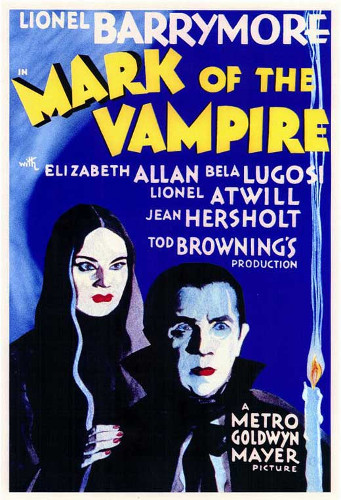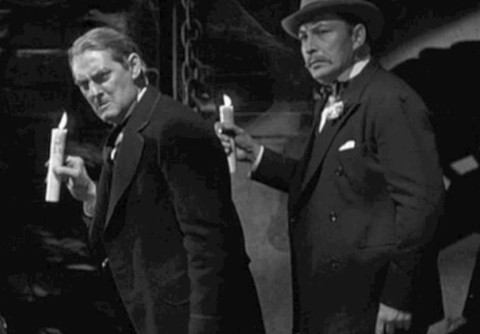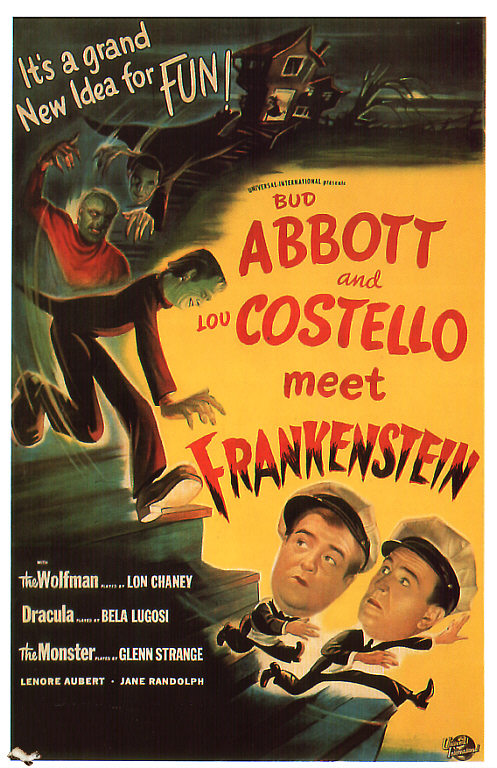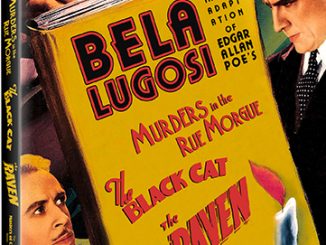Mark of the Vampire (1935)
Directed by: Tod Browning
Written by: Bernard Schubert, Guy Endore, H.S. Kraft, John L. Balderston, Samuel Ornitz, Tod Browning
Starring: Bela Lugosi, Elizabeth Allan, Lionel Atwill, Lionel Barrymore
USA
AVAILABLE ON DVD AND DIGITAL
RUNNING TIME: 60 mins
REVIEWED BY: Dr Lenera
SPOILERS!

In Prague, Sir Karell Borotyn is found murdered in his house, with two tiny pinpoint wounds on his neck. The attending doctor, Dr. Doskil, and Sir Karell’s friend Baron Otto von Zinden, are convinced that he was killed by a vampire. They suspect Count Mora and his daughter Luna who live in the nearby Borotyn castle which is virtually in ruins, but Police Inspector Neumann refuses to believe them. Sir Karell’s daughter Irena is the Count’s next target. Professor Zelen, an expert on vampires and the occult, arrives in order to prevent her death….

I try not to be as spoilerific as I used to be, but there’s no getting around the fact that, for a detailed discussion of this film, one has to bring up its big revelation because it’s so important. I recall first seeing it on TV around four decades ago when such movies frequently adorned the late night schedules and I often had to sneak downstairs once my parents had gone to bed to watch them. I was really into what seemed to be a pretty good vampire chiller; exciting and with some really effective moments that gave some chills to this ten-year old. And then suddenly the rug was pulled out from under my feet and the two vampires, plus two other characters [though one’s forgotten about] were actually impostors involved in a scheme to unmask a murderer. This, of course, makes it a remake of 1927’s Lon Chaney-starrer London After Midnight [a film thought lost though we keep hearing rumours of found prints and I so badly want to see it], though I warrant that the revelation in that film makes a bit more sense than the utter nonsense here. It’s just plain ridiculous because we supposedly have this elaborate vampire charade as part of a plan to force a confession from a killer, yet there remain a lot of unexplained events. The killer doesn’t even see many of the fake supernatural manifestations; in fact some of them are only seen by us, the viewer. Of course the 1920’s had a tradition of ending horror tales with rational explanations such as The Cat And The Canary, but one wonders why MGM thought to bring this back seeing how supernatural horror had become big business in the interim – but of course that’s not the real problem. The real problem is how hardly anything adds up, and it puts a fatal damper on what is otherwise a decent attempt by MGM to emulate the Universal horror films, with director Tod Browning, who’d began the cycle with his smash hit Dracula, seemingly relishing the opportunity to top the earlier film in places. It’s very influential in one aspect too.
Based on a short story by Browning called The Hypnotist [which became its British theatrical title] clearly inspired by London after Midnight, the first script for this was written by novelist Guy Endore [who also wrote The Werewolf Of Paris which was very loosely filmed as Hammer’s The Curse Of The Werewolf], and was called Vampire Over Prague. It reputedly hinted at an incestuous relationship between Mora and Luna. Bernard Schubert heavily rewrote Endore’s material, along with the uncredited John L. Balderston, H. S. Kraft and Sam Ornitz who became one of the Hollywood Ten who were blacklisted because of their supposed Communist sympathies. Some sources say that the ending was kept a secret from the cast in case the knowledge that the two vampires weren’t actually real would hamper their performances, though I doubt that, seeing as London After Midnight would have still been in the memories of many. However, an alternate ending was considered in which Professor Zelen receives a telegram from the hired actors revealing that they were unable to make their train, thus implying that the vampires the film depicts were real after all. Why on earth Browning rejected this much better conclusion is anybody’s guess. Browning was renowned for giving his cast and crew a hard time, never being satisfied and driving people to exhaustion. On this set, he’d frequently grumble, “Mr. Chaney would have done better”. The original cut was 75 mins long and lost 15 mins of comic relief involving Maria the maid as well as the knowledge that Count Mora shot himself after strangling his daughter and was condemned to eternity as a vampire, which explains the otherwise unaccountable spot of blood which appears on Lugosi’s right temple during the film. It did okay business and drew the usual poor reviews for a horror film of the time, while Lugosi criticised the ending several times to interviewers.
.
The titles take place over one of those unrealistic but beautiful foggy graveyard sets that us lovers of the Gothic just adore, and then we get a clumsy bit, even for the time, where we descend from a church steeple in daylight and then a wipe transports us to the bottom at nighttime where some gypsies are singing. Cut to an old lady gathering grass by the graveyard until she’s surprised by a bat and flees, though not before getting her coat trapped in a digging fork. In the local inn, a couple’s request to be taken somewhere at night is denied in the expected manner to mockery from the couple at the backwards idiocy of these peasants. At the pub is a Dr. J, Goskill, who has to rush off because there’s just been a murder. The victim is Karell Borotyn, killed just two weeks before the wedding of his daughter Irena to fiancee Fedor Vincent. Karell’s body was found with two marks on his neck and drained of blood. The superstitious villagers suspect vampirism and finger Count Mora and his daughter Luna who possibly live in the rundown, very old and supposedly deserted Borotyn castle, but the level-headed Inspector Neumann won’t buy that. Some of the most enjoyable non-vampire scenes involve Neumann pitting his rational beliefs against those of the Van Helsing-substitute Professor Zellen. Lionel Atwill is on fine form as Neumann, but even this veteran scenery chewer is no match for Lionel Barrymore as Zellen who delivers every line with lip-smacking relish even though he seems to have great difficulty in standing on two feet; in actual fact he was generally wheelchair-bound due to rheumatism that forced him to be seated in most of his later films.

Irena goes to live in the house of guardian Baron Otto von Zinden, but is in her garden late one evening [these scenes aren’t nearly dark enough but this was the norm back then] when Luna approaches her and hypnotises her to sit down on a chair where she bites her. Of course the actual biting is unseen, but it’s still interesting to see a very slight suggestion of lesbianism in a vampire film for the first time – Dracula’s Daughter wasn’t made till a year later. Then Fedor stumbles into Irena’s bedroom with two marks on his neck, complaining that he fell and hit his head outside the Borotyn castle, though the premise of him being slightly vampirised doesn’t have much done with it. Zellen orders the house not to be full of garlic but a “thorny weed” called bat thorn, and even says later that the only way to kill a vampire is decapitation followed by bat thorn put on the “gaping wound”. What a shame that, to my knowledge, this is the only vampire film which has these unique laws, though come to think of it didn’t Browning’s Dracula have wolfsbane? What on earth was wrong with garlic? When Karell’s signature is found on a lease signed after his death and when Irena claims to have heard her father’s voice, Neumann and Otto dig up Karell’s coffin and find it empty. The undead Karell doesn’t seem to be a vampire though, he’s just a zombie who plays the piano to Zellen, Mora and another undead accomplice – though when entered later on, everything in the room is covered and the piano ruined and unplayable, in a nice variant on one of my favourite cliches – though was it a cliche back in 1935? Things seem to be leading to a fine confrontation in the castle, hopefully bettering the non-event Browning staged with Lugosi in 1931 – and then the twist is revealed and we see somebody hypnotising somebody [so all this complex vampire stuff hasn’t worked] to reenact a murder he’s suspected of carrying out, which isn’t a bad idea and has been well used elsewhere but just seems ridiculous here, while many things like Mora flying with bat wings [in probably the most startling of the visuals and surprisingly convincing too] are just left unexplained.
Despite supposedly being set in present day Prague, the setting is the usual Mittle Europe of the Universal pictures. The dilapidated castle is terrific, perhaps even better than the one in Dracula despite being a tad lighter. It’s more detailed and there’s a surprising sense of geography even though we don’t spend that much time in it. This one really does attract the wildlife; bats, spiders, rats and even ants are around, along with cobwebs huge in both number and size, and this film manages to pull off more convincing bats than Hammer ever did. Much of the film is set in von Zinden’s house, its lush, expansive interiors betraying the fact that this is an MGM rather than a Universal production, but despite this there’s quite a good feeling of fear as to when these vampires are going to come in again. Yet even in the extent cut, there’s still some humour here and there, usually from minor characters; in fact I’d say that it’s just the right amount and may have been too much in the original version which totally cut out Robert Greig, Eily Maylon, Zeffie Tilbury and Jessie Ralph even though the last of these is still credited. It was a shame to remove those fine character actors, but it sounds as if MGM weren’t sure what Mark Of The Vampire was supposed to be, or originally planned it to be more of a comedy than a horror. In the version we have, the laughs don’t detract from the atmosphere. The two house servants are very easily frightened which is milked somewhat, but there’s a good moment when the visor of a suit of armour seems to be moving and it turns out to be doing this because of a cat. There’s also a woman who’s being driven home in her carriage very quickly before she espies a vampire. “I’ve been a good girl all my life”, she pleads.
Lugosi and Caroll Borland often stalk about to appropriate background noise which may come across as corny today but which probably gave 1935 audiences some nice chills. Lugosi gets far less screen time than Borland and doesn’t even have anything to say until the final scene, but of course Lugosi is Lugosi, he has that unique screen presence and manner that made him one of a kind, and is possibly given his scariest screen few seconds in this film when he lunges at the viewer with a snarl. Even better though is Borland who gets to deliver a fantastic hiss of the kind vampires didn’t otherwise do until Hammer came onto the scene. Her long black hair, white skin and staring eyes are virtually the prototype for the whole anaemic Goth look, and were a direct inspiration for Morticia in The Addams Family as well as TV horror hostesses Vampira and Elvira. Borland is mesmerising in the role and it doesn’t matter that she also doesn’t get to say a single thing until the end. Sadly Elizabeth Allan and Henry Wadsworth are very bland as the romantic leads, though that’s often the case, and it’s interesting for the time that the latter plays an ignorant idiot easily outshone by the former. Browning was usually a rather static director, though here with James Wong Howe behind the camera, there’s more camera movement than usual. Overall Mark Of The Vampire is really rather good until its awesomely idiotic denouement which almost entirely throws away what proceeded it. It’s just so bloody stupid in so many ways, such as when somebody drinks poisoned wine meant for someone else and is absolutely fine. Yet even I couldn’t help but like the moment when, after us waiting ages to hear that voice, Lugosi right at the end says, “This vampire business, it has given me a great idea for a new act. Luna, in this new act I will be the vampire. Did you watch me? I gave all of me. I was greater than any real vampire”.
Rating: 














Be the first to comment